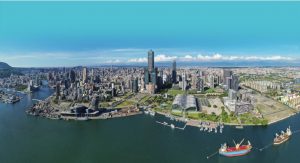
In the 1970s, Chinese Taipei transformed from an agriculture society to an industrial society. The central government then promoted the “Ten Major Construction Projects”. Among these projects are the heavy industry that led to high pollution, such as the steel industry, petrochemical industry, naval architecture, and they are located to Kaohsiung by policy. Although this led to Chinese Taipei’s economic miracle, but it also burdened Kaohsiung with pollution for more than half of the century.
After the Paris Agreement was established, Kaohsiung City Government had come up with a strategy, “Mitigation and Adaptation Strategies & Actions in Kaohsiung City”. Kaohsiung City’s Roadmap to GHG Emissions Reduction includes carbon reduction in sectors such as the energy sector, manufacturing sector, housing sector, agriculture sector and the transportation sector.
In 2020, the industrial and manufacturing sectors’ energy usage accounted for 81.96% of the GHG emissions in Kaohsiung, implying that the two industries play a major role in the City’s plan to reduce carbon emissions. Kaohsiung had started a climate adaptation committee to respond climate change and take sustainable actions since 2012. As a result, Kaohsiung’s GHG emissions decreased to 53.31 million metric tons in 2020. In comparison to 2005, GHG emission is 19.4% lower. As the energy usage from the two sectors are still quite high, Kaohsiung City decided to focus and put more work on carbon emission reduction on the these two sectors.
In terms of energy, as Kaohsiung city is located south of the Tropics of Cancer, the city receives over 2100-2300 hours of sunlight on an yearly basis. Combining this with the mature solar energy industry, and incentives and policy frameworks on green energy, Kaohsiung’s 2050 Net-Zero, Sustainable Smart Kaohsiung Master Plan was set.
Kaohsiung’s energy transformation isn’t as simple as other cities whose main industries aren’t heavy industry. But Kaohsiung is able to shift from having industries that cause high pollution, through the implementation of solar energy, to attract high-tech industries that are low-carbon to land in Kaohsiung. And this is a virtuous cycle that ultimately leads to the city’s reduction of GHG emission.
With the “Green Energy Promotion Task Force” established, and in the first year for this project, the goal was exceeded with 295 MW of solar energy capacity. Solar panels are placed on the roof-tops of the over public buildings, 333 schools, and aquaculture farms through public-private partnership, and the city-level EMS is being built to capture the energy data for Kaohsiung City.
As Kaohsiung switches gears to include smart technology to its energy transformation, heavy industry is gradually being replaced with high-technology, low-carbon industries, and Kaohsiung City is cooperating with the central government to accelerate and prepare in advance for this.
For smart and low-carbon transportation, not only did the city promote MaaS service with the use of mobile devices, including Kaohsiung MRT, light rail, bus, shared vehicles, ferries, but also first city ever provide bicycle sharing service by solar power supply in Chinese Taipei. Simultaneously, Kaohsiung is prompting the replacement of electric public transport vehicles.
Kaohsiung isn’t limited to digital transformation, but energy transformation on a citywide scale.
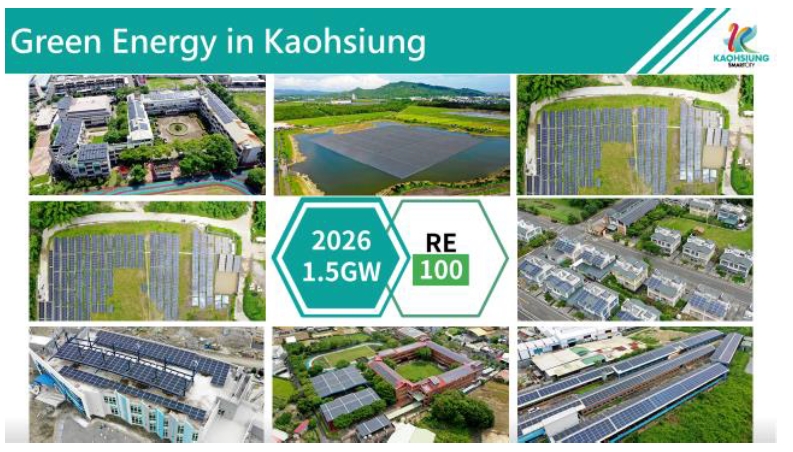
Expected Future Development
Expected demographic changes:
1. According to the demographic data, from 2011 to 2016, the growth of population in Kaohsiung city is increased. Since 2017, the population of growth is decreased. By 2021, the number of population is 2,744,691, compared to the population in 2021.The number of population is relatively decreased by 28,792.
2. Affecting by the ageing population and low birth rate, it’s estimated that the population growth in Kaohsiung in next decade will be declined and by 2027, the population of Kaohsiung city is expected to drop below 2.7 million.
Expected industrial/economic changes:
Base on solid industrial infrastructure and excellent international airport and harbor, the economic development of Kaohsiung city affecting by the international market deeply. Due to the China-US trade war and COVID-19 pandemic from 2019-2020, the growth of economic is slightly declined. With the return of overseas Chinese Taipei capital increased and the popularization of vaccines in recent years, Kaohsiung has gained local stable productivity, along with global economy recovering to drive the industries needs against the trend.
1. Towards the Emerging Technologies Industries
(1)Accelerating the Promotion of Qiaotou Science Park
In response to the booming investment in Kaohsiung and the increased demand for industrial land, the city government actively cooperated with the central government to accelerate the development of Qiaotou Science Park, and formed an investment promotion team with the Southern Chinese Taipei Science Park Bureau to share resources and actively attract investment from international materials and semiconductors companies, in order to strengthen the supply chain of the semiconductor industry in southern Chinese Taipei.
Qiaotou Science Park, in total of 262 hectares for land use and 164 hectares for factory use, is one of the few science park which provided such large amount of land in Chinese Taipei. In line with the “Chinese Taipei’s 2030 Science and Technology Vision”, the industries, such as semi-conductors, aerospace, smart machinery, precision medicine and 5G/6G internet and AI software service and related new venture industries will be the focal point to be introduced with the direction of upgrading local industries and developing towards “AIoT” aspect. It is estimated that within 10 years, the annual output value will reach NTD 180 billion and 11 thousands of employment opportunities will be created.
Qiaotou Science Park, located in the area of Qiaotou new township, is the only science park provide Enterprise Income Tax credit in Chinese Taipei. Other than that, the city hall also provides subsidies such as financing interest, real estate rent and labor wages, etc. to fully support on recruiting international major firms and leading the transformation of local industries. In next decade, Qiaotou Science Park will become the crucial site for the future development of emerging new technologies industries in Chinese Taipei.
(2)Kaohsiung Nanzih Technology Industrial Park to Complete Southern S Technology Corridor
In response to the Executive Yuan’s policy of “Foresight Research and Layout of Chinese Taipei’s Industries under the Tech Cold War Between the U.S. and China”, and in order to promote economic development, accelerate industrial transformation and high value, and meet the needs of the land use requested by the industries, the Kaohsiung Refinery Plant in the Nanzih District was selected as the base of the Nanzih Industrial Park in accordance with the “Industry Innovation Regulations” This industrial park covers an area of about 29.83 hectares. With excellent industrial lands and key investments from key players from the semiconductor industry, it becomes the key puzzle to complete the Southern Semiconductor S Corridor. At present, the renovation has been completed, and TSMC is planning to land. Nanzih Industrial Park is connected to Luzhu in the north, with Qiaotou Science and Technology Park to Southern Chinese Taipei Science Park forming a semiconductor manufacturing cluster. To the south, there is Dadu, Renwu, Daliao, Linyuan, Xiaogang (Dalinpu), forming a semiconductor material and petrochemical industry cluster. In combination with advanced manufacturing semiconductor companies in the south, this leads the development of the city to have more value and to deepen the foundation for industrial development. And this leads to the local economic prosperity and abundant job opportunities.
Chinese Taipei’s semiconductor industry has risen to global competitiveness, and is ranked number 1 or 2 globally in areas such as wafer fabrication, packaging and testing and the production of wafer. Qiaotou Science and Technology Park, Nanzih Industrial Park, and Kaohsiung Bay Area 5G AIoT Innovation Hub are bringing in more demands, and in the future will integrate every process in the semiconductor industry, from downstream, packaging and testing and manufacturing, to upstream, IC design, system integration. In combination with semiconductor material and equipment, this will complete the semiconductor industry cluster, and have a synergistic effect, increasing job opportunities in Kaohsiung.
2. Industrial Parks Upgrade
(1)Ho Fa Industrial Park
Ho Fa Industrial Park, set up in 2014, is the first Industrial Park ever in accordance with “Statute for Industrial Innovation” to set up and approved by government. The base, with the total 136 hectares of development area and around 93 hectares of industrial land, is located on the north side of the Dafa Industrial Zone under the jurisdiction of the Ministry of Economic Affairs and currently have 62 manufacturers set up factories and start the business. In cooperation with important industrial policy of 5G AIoT technology to accelerate the digital transformation of industry, the Industrial Park will work with the stationed companies by providing opportunities and site of 5G new industries application, and actively fight for the support of central government, in order to build up a new demonstration site combined with 5G technology.
(2)Ren Wu Industrial Park
Base on the demand of local industrial land use and acceleration of development of economy and industry, “Ren Wu Industrial Park”, with 74 hectares land use, is set up in accordance with “Statute for Industrial Innovation”, but the further land acquisition and works are in progress.
Apart from introducing surrounding aerospace industries (metal products) as planned and forming the aerospace settlements in Central Kaohsiung and North Kaohsiung, the city hall is expecting through the provision of industrial land and policy consultation for unregistered illegal factory, to lead the transformation of Kaohsiung industry. The industrial park is expected to release 48 hectares of industrial land use, create 6,300 job opportunities and increase the annual output value of NTD 24.2 billion and reforming the industry transformation.
The listed company Tian Zheng International PRECISION MACHINERY CO., LTD. , as the first stationed company in the industrial park, took the lead in holding groundbreaking ceremony in January 2022. It’s expected to expand the semi-conductors and Mini LED machine product line in over NTD 1 billion investment to introduce the brand new AIoT technology. By the end of 2022, the construction of product line will be completed and created around NTD 22 billion product value and brings in 200 employment opportunities.
3. Initiative Circular Economy Industrial Park
After the approval of “set up application” (including Dalingpu relocation) from Executive Yuan, the industrial park is estimated to be completed by 2028 and increased 210.91 hectares of land use of industrial land use in Kaohsiung area and create 9,765 employment opportunities.
Through set up of “Circular Economy Industrial Park”, it’s expected to integrated the energy resource, such as, oil, electricity, steel, and incorporated with the stationed companies to mutual exchange and reuse all the raw materials, side products, waste, which are produced or needed during the production process between stationed companies in the industrial park through electricity and heat energy, and further gathering a Circular Economy co-cluster.
4. Future Prospect
Kaohsiung City will focus on the promotion of Renwu Industrial Park development, and collaborate with the central government, who facilitates the construction of “New Material Innovation Hub”, “Material Circular Economy Industrial Park”, “Nanzih Industrial Park, and Qiaotou Science and Technology Park. This will attract R&D talents. The city’s new material circular economy industries in combination with the semiconductor and steel industrial chain will develop into an innovative technology industry cluster.
Other expected development:
Low-carbon Smart Transportation.
Kaohsiung city has comprehensive MRT/ light rail network, connect MRT, light rail, shared vehicles, ferries and provide service for more than 2 million populations, and create a multi-core 20 min public transportation living sphere.
1. Circular Light-rails:
The construction of circular Light rails will be finished by 2023. It’s expected to connected the Metro red line and orange line to serve 1,5 miliion citizens in downtown area.
2. Metro Red Line Extension:
Extend the original red line towards north 12 km, and finished the construction by 2029, and could serve 350K citizens.
3. Metro Yellow Line:
Under construction. Connected the Metro red line and orange line and Circular Light rails. It’s estimated to be completed by 2028 and serve 1,5 million citizens.
4. Metro Blue Line:
Planning. Extend the original Metro red line towards south 11.6 kilometer. It’s expected to be completed by 2030 and serve 300K citizens in south Kaohsiung industrial area.
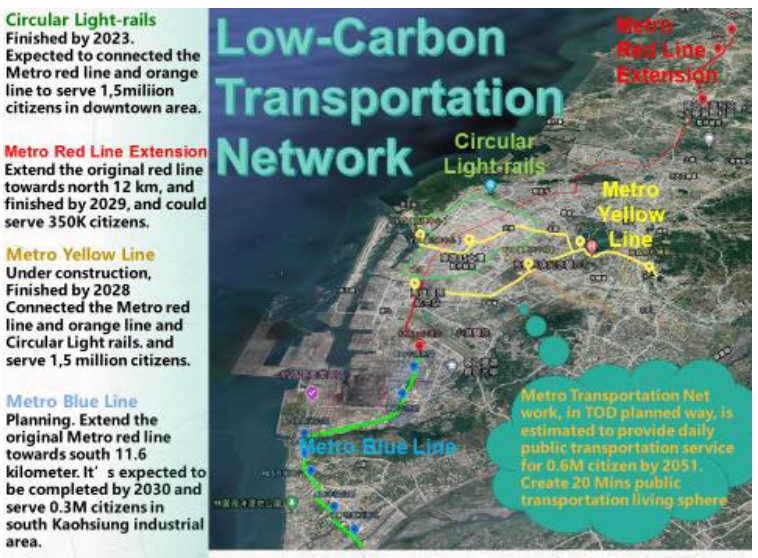
Town Policy, Vision or Objective
What is the policy, vision, or objective of the town?
Approaching 2050 Net-Zero, Sustainable Smart Kaohsiung:
(1) 1.5 GW Solar Energy Generation in 6 years, Reduction of 1 Million Carbon-Dioxide Emission
(2) City-Level Green Energy Management Platform, Managing Over 3 Billion KW of Green Energy, Creating Revenue for City Government.
(3) From Heavy Industry to Semiconductor Clusters, Lowering Carbon Emission.
(4) Low Carbon Emission Smart Transportation Network, Creating 20-Minutes Public Transportation Living Sphere, Servicing Over 2 Million Citizens
Brief outline of the low carbon town development plan:
In the 1970s, Chinese Taipei transformed from an agriculture society to an industrial society. The central government then promoted the “Ten Major Construction Projects”. Among these projects are the heavy industry that lead to high pollution, such as the steel industry, petrochemical industry, naval architecture, and they are located to Kaohsiung by policy. Although this led to Chinese Taipei’s economic miracle, but it also burdened Kaohsiung with pollution for more than half of the century. In addition, Kaohsiung generates a quarter of Chinese Taipei’s overall electricity power, and most of them is generated by fired power stations. Thus, actions that deal with sustainability, such as pollution reduction, lowering GHG emission, clean energy, become the imminent problem that Kaohsiung city planned to solve while digital transformation plays a key role.
Kaohsiung had started a climate adaptation committee to respond climate change and take sustainable actions since 2012. As a result, Kaohsiung’s GHG emissions decreased to 53.31 million metric tons in 2020. In comparison to 2005, GHG emission is 19.4% lower and the reduction of the GHG emission is over 12.85 million tons per year. This achievement is the best in comparison to any other cities among Chinese Taipei. Under measurements from city hall, the highest reduction of GHG/carbon emission was contributed by “Industry sector”, which was 11.31 million metric tons reduction, 20.2% lower compared to 2005. In addition, “Agriculture Sector” and “Waste Sector” both as the second highest carbon emission sectors, are respectively 28% and 68.9% lower. On top of that, Kaohsiung takes more measures on upgrading the industrial structure, green energy, and traffic sector.
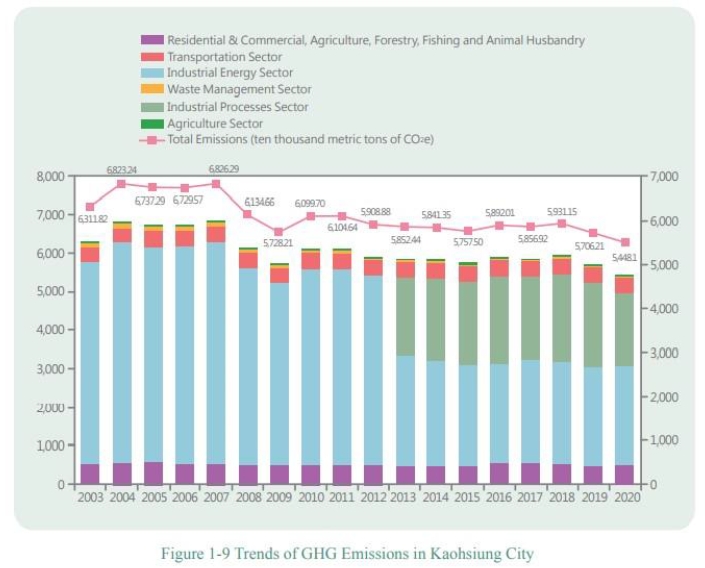
Here are some carbon-reduction measurements:
1.New Policies for Green Energy 2021, Upgrade of the Industrial Structure:
Due to Kaohsiung city is located south of the Tropics of Cancer, and receives over 2100-2300 hours of sunlight on a yearly basis. Such great solar irradiance condition, combined with the mature solar energy industry in Chinese Taipei, Kaohsiung has great potential for the green energy, especially solar energy.
Having an excellent condition isn’t enough, there needs to be incentives and suitable legal framework to promote the development, and to attract businesses or citizens to get involved. Kaohsiung City Government, since 2021, had started a “Green Energy Promotion Task Force”, and was the first in Chinese Taipei to promote the 4 policy framework for solar panels on the roof-tops of the public buildings and green building. During 2012-2020, Kaohsiung had increased the solar energy capacity by 750MW, which is equal to 510K TOE per year. But the number of newly built solar panels gradually decreased consecutively in 2019 and 2020. As a result, new incentives and deregulation is required to attract more participants into solar energy.
In 2021, Kaohsiung City implements new policies on green energy focused on energy generation, energy conservation and energy storage to promote low-carbon sustainable green energy:
(1) On energy generation, Kaohsiung City had planned to increase 1.5 GW solar energy capacity over the next 6 years. This is expected to lower 1 million TOE per year. In the first year for this project, the goal was exceeded with 295 MW of solar energy capacity, and the government doesn’t need to pay for the implementation, and receives the profits shared by energy retailer. Simply put, there’s 3 strategies:
(A)Solar panels placed on the roof-tops for the public building: the government leads to place solar panels on the public building and the public area, such as the city hall, markets, parking lots…etc. the implementation cost is transferred from the city government to the private sector through bids and tenders. The government receives the royalty, and the businesses receives the revenue from selling the generated electricity. The government also supports the private housing through subsidies. Through public-private partnership, the goal of Kaohsiung City solar panel implementation is made possible.
(B)School districts’ smart green energy, and energy management system: School buildings have solar panels installed on the roof-tops. The implementation cost is transferred to the businesses. The revenue from selling the electricity is shared to the schools as rebates. In 2021, 333 schools have solar panels installed out of 352 schools in Kaohsiung City.
(C)Prioritized section for fishery and electricity symbiosis: aquaculture is an important industry in Kaohsiung. Through collaborating with the central government to designate the aquaculture lands that are prioritized for solar panel installation. This increases the administrative efficiency for the project implementation. Currently, over 70% of the aquaculture lands are designated for the priority section for solar panels. When installed completely, these aquaculture lands are able to provide 2 GW of solar energy capacity.
(2) On energy conservation, the city government called upon the industry, universities, hospitals and hotels to matchmake with energy saving companies (ESCO) to implement energy saving processes. In 2021, 5 businesses are able to reduce GHG emission by over 1500 TOE per year. Kaohsiung City Government also invites successfully transformed businesses to share their success stories to other businesses, and continuously promote, guide and support more and more businesses.
(3) On energy storage, some of the sites have the energy requirement 24/7. Thus, when installing solar panels, energy storage equipment is also installed to be put to use during the night-time.
City level green energy management platform, as another one of the highlights of green new policy, manages Kaohsiung green energy supplement in general and has four features:
(1) The scale of green energy cases management platform is the largest in Chinese Taipei.
(2) a variety type of renewable energy generating: rooftop, ground, water surface and fishery and electricity symbiosis through solar photovoltaic, hydraulic or biomass energy generation.
(3) Energy generating, Energy efficiency and Energy conservation through single platform.
(4) implement the renewable energy certificates and renewable energy matching and trading mechanism in the future, and encourage local generating units use renewable energy, in line with the future tend of carbon tax.
The aforementioned measurements of energy transformation are not only carbon reduction, but also bring in many job opportunities in Kaohsiung. Other than the demand for solar photovoltaic engineer, green energy is also the positive incentives to attract the investment of high-tech companies, which had join the RE100 projects. Currently, there are many international leading semi-conductor corporations, like TSMC, Merck, ASE Group, WIN, Entegris and so, invest in Kaohsiung. Other local companies are also promoting ESG, low-carbon and green energy-saving movement. At the same time, the city is also encouraging companies like Yong Cheng green energy co., to balance the development between aquaculture and green energy through infrastructure of fishery and electricity symbiosis.
2. Smart and Low-Carbon Transportation
Kaohsiung is dedicated to provide smart and low-carbon transportation. Not only did the city promote MaaS service with the use of mobile devices, including Kaohsiung MRT, light rail, bus, shared vehicles, ferries, but also first city ever provide bicycle sharing service by solar power supply in Chinese Taipei. Simultaneously, Kaohsiung is prompting the replacement of electric public transport vehicles. There are currently 194 electric buses and 3 electric ferries in Kaohsiung and reduce over 10 thousand TOE per year. It’s estimated that all transport vehicles will be completely electrified by 2035.
3. Smart Energy-Saving Building
It is estimated to build over 10 thousand smart energy-saving public housing in next five years in Kaohsiung city. Every household will be installed smart water and electricity meter for unified the management of energy consumption and use efficiency of various equipment, and also installed the energy management system for instant visualization of major energy-consuming appliances. At the same time, the installed solar photovoltaic and energy conservation system in public housing will not only manage, but also create and save energy.
4. Smart Grid
Taipower company sets up the only 5G AIoT smart electricity office in Kaohsiung to do research regarding the smart grid with 5G AIoT and energy-saving projects, and promote the smart inspection related to drone, MR applications, as well. Kaohsiung will become the demonstration site for smart inspection combined with 5G AIoT smart grid, drone application and MR.
5. Smart employment and consumption
Other than accomplished the installation of solar photovoltaic panel in 333 schools, Kaohsiung city even built the school energy management system, in order to reduce the campus energy consumption through intelligent management. Through the development of school solar photovoltaic and energy management system, students get to educate the importance of energy in practical way and promote the concept of energy-saving at the same time.
Project Management
What central/local government departments are/will be involved in development of the project?
Stakeholders involved
1. New Policies for Green Energy 2021
(A)Solar panels placed on the roof-tops for the public building
Initials:Environment Protection Bureau, Kaohsiung City Government, Urban Development Bureau, Kaohsiung City Government, Public Works Bureau, Kaohsiung City Government
Planning: Public Works Bureau, Kaohsiung City Government, Environment Protection Bureau, Kaohsiung City Government, Economic Development Bureau, Kaohsiung City Government
Execution: Urban Development Bureau, Kaohsiung City Government, Finance Bureau, Kaohsiung City Government, Marine Bureau, Kaohsiung City Government, Agriculture Bureau, Kaohsiung City Government, Education Bureau, Kaohsiung City Government, Water Resources Bureau, Kaohsiung City Government, Civil Affairs Bureau, Kaohsiung City Government, Environment Protection Bureau, Kaohsiung City Government, Transportation Bureau, Kaohsiung City Government, Information Management Center, Kaohsiung City Government, Land Administration Bureau, Kaohsiung City Government, Mass Rapid Transit Bureau, Kaohsiung City Government, Mass Rapid Transit Bureau, Kaohsiung City Government, Public Works Bureau, Kaohsiung City Government, Economic Development Bureau, Kaohsiung City Government
Assessment/Evaluation: Green Energy Promotion Task Force, Kaohsiung City Government
(B)School districts’ smart green energy, and energy management system:
Initials: Environment Protection Bureau, Kaohsiung City Government, Education Bureau, Kaohsiung City Government, Public Works Bureau, Kaohsiung City Government
Planning: Public Works Bureau, Kaohsiung City Government, Environment Protection Bureau, Kaohsiung City Government, Education Bureau, Kaohsiung City Government
Execution: Education Bureau, Kaohsiung City Government, Public Works Bureau, Kaohsiung City Government, Economic Development Bureau, Kaohsiung City Government
Assessment/Evaluation: Green Energy Promotion Task Force, Kaohsiung City Government
(C)Prioritized section for fishery and electricity symbiosis:
Initials: Urban Development Bureau, Kaohsiung City Government, Marine Bureau, Kaohsiung City Government
Planning: Marine Bureau, Kaohsiung City Government, Land Administration Bureau, Kaohsiung City Government
Execution: Ministry of the Interior, Bureau of Energy, Ministry of Economic Affairs, Marine Bureau, Kaohsiung City Government, Land Administration Bureau, Kaohsiung City Government, Urban Development Bureau, Kaohsiung City Government
Assessment/Evaluation: Green Energy Promotion Task Force, Kaohsiung City Government
(D) City-Level Green Energy Management Platform:
Initials: Green Energy Task Force, Kaohsiung City Government
Planning: Public Works Bureau, Kaohsiung City Government, Economic Development Bureau, Kaohsiung City Government
Execution: Economic Development Bureau, Kaohsiung City Government, Urban Development Bureau, Kaohsiung City Government, Finance Bureau, Kaohsiung City Government, Marine Bureau, Kaohsiung City Government, Agriculture Bureau, Kaohsiung City Government, Education Bureau, Kaohsiung City Government, Water Resources Bureau, Kaohsiung City Government, Civil Affairs Bureau, Kaohsiung City Government, Environment Protection Bureau, Kaohsiung City Government, Transportation Bureau, Kaohsiung City Government, Information Management Center, Kaohsiung City Government, Land Administration Bureau, Kaohsiung City Government, Mass Rapid Transit Bureau, Kaohsiung City Government, Mass Rapid Transit Bureau, Kaohsiung City Government, Public Works Bureau, Kaohsiung City Government
Assessment/Evaluation: Green Energy Promotion Task Force, Kaohsiung City Government
2.Low Carbon Transportation Network:
Ministry of Transportation and Communication, National Development Council, Ministry of Economic Affairs, Transportation Bureau, Kaohsiung City Government
3.Energy Conservation Service Model Facilitation and Electricity Low Carbon Action Plan:
Industrial Development Bureau, Ministry of Economic Affairs, Economic Development Bureau, Kaohsiung City Government
4.Manufacture Industry Energy Management Demonstration Guidance Project
Industrial Development Bureau, Ministry of Economic Affairs, Economic Development Bureau, Kaohsiung City Government
What private company, non-governmental organizations are/will be involved in development of the project?
Stakeholders involved
1. New Policies for Green Energy 2021
• Electricity Power company
• PV panel related Associations
• Research Institute/Universities
Solar energy companies that the city government works with are also gender-inclusive. There are female planners and employees, and people that are in their second career. Education seminars and associated programs are provided by these companies.
2. Energy Conservation Service Model Facilitation and Electricity Low Carbon Action Plan:
Energy saving service provider and related association
3. Low Carbon Transportation Network:
Electric Bus Business partners and bus operators.
How is/will be the development of the town funded?
1. New Policies for Green Energy 2021
Local Government funded $1.2M USD to facilitate legal framework, match-making, and will share profits of energy retailer, estimated over $2.2-3M USD per year.
2. Energy Conservation Service Model Facilitation and Electricity Low Carbon Action Plan
Local Government funded $30M USD Last 5 years
Project Website:
• https://ksepb.kcg.gov.tw/EPBusiness/BusinessH.htm
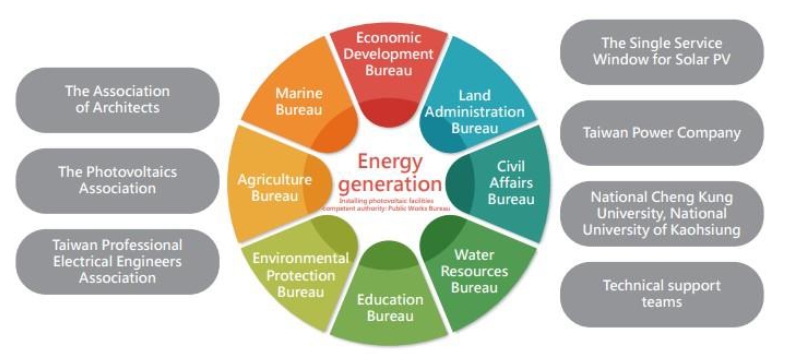
•
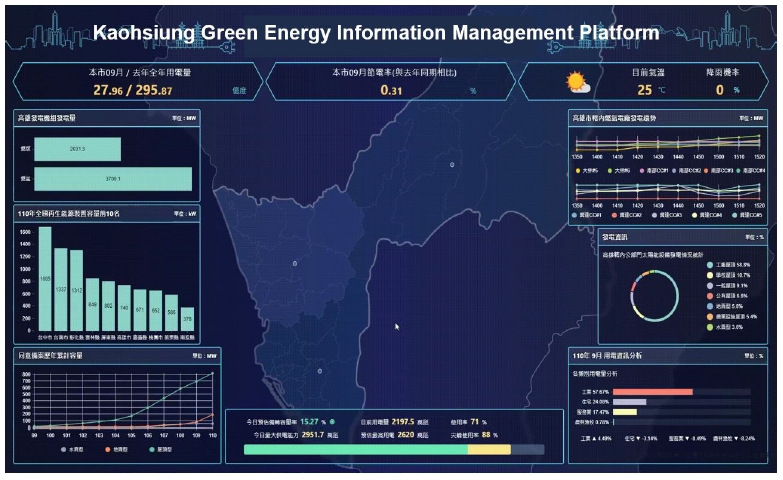
•
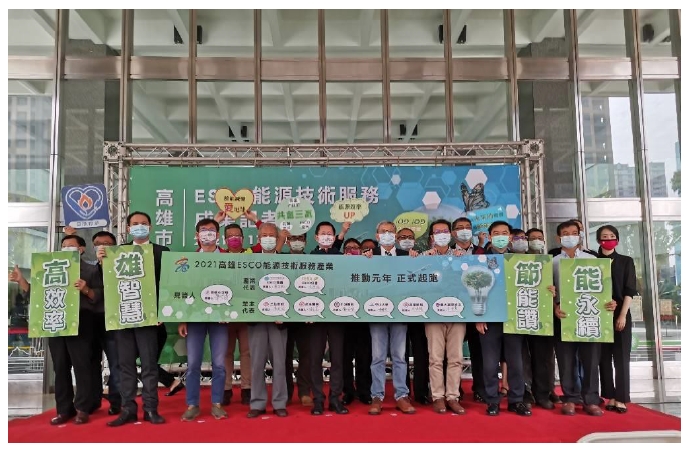
Estimated cost savings in implementing low-carbon measures (per year/per unit of energy, etc.)
– Urban Sector: 2M TOE/year
– Public buildings roof-top PV panel: 65K TOE/year
– Transport sector: 1M TOE/year
– Commercial sector: 5.3M TOE/years(New job opportunities from Low-carbon emission High-tech Industries)
– Renewable energy: 0.83M TOE/year in 2020, and estimated 1.95M TOE/year in 2026
– Other, such as waste/ Agriculture sector: 1.2M TOE/year